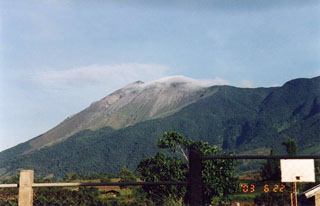Report on Kanlaon (Philippines) — 4 June-10 June 2025
Smithsonian Institution / US Geological Survey
Weekly Volcanic Activity Report, 4 June-10 June 2025
Managing Editor: Sally Sennert.
Please cite this report as:
Global Volcanism Program, 2025. Report on Kanlaon (Philippines) (Sennert, S, ed.). Weekly Volcanic Activity Report, 4 June-10 June 2025. Smithsonian Institution and US Geological Survey.
Kanlaon
Philippines
10.4096°N, 123.13°E; summit elev. 2422 m
All times are local (unless otherwise noted)
The Philippine Institute of Volcanology and Seismology (PHIVOLCS) reported continuing unrest at Kanlaon during 3-9 June. The seismic network recorded 3-26 daily volcanic earthquakes. Daily sulfur dioxide emissions ranged from 1,355 to 5,324 tonnes per day. Gas-and-steam emissions of variable densities generally rose as high as 900 m above the crater rim and drifted in various directions. According to the Tokyo VAAC PHIVOLCS reported that at 0203 on 5 June an ash plume rose 3.7 km (12,000 ft) a.s.l., or about 1.3 km above the summit. Ash was not identified in satellite images. The Civil Defense PH issued a notice to be aware of potential ashfall in surrounding areas. On 6 June heavy rains generated cement-like lahars on the S and SW flanks, along the Buhangin River (which flows through La Castellana and Moises Padilla), along the Sitio San Luis River, and beneath the Hacienda 92 Bridge in Barangay Sag-ang, and along the Ibid Creek in Barangay Biak-na-bato, La Castellana. The Alert Level remained at 3 (on a scale of 0-5); the public was warned to stay 6 km away from the summit and pilots were warned not to fly close to the volcano.
Geological Summary. Kanlaon volcano (also spelled Canlaon) forms the highest point on the Philippine island of Negros. The massive andesitic stratovolcano is covered with fissure-controlled pyroclastic cones and craters, many of which are filled by lakes. The largest debris avalanche known in the Philippines traveled 33 km SW from Kanlaon. The summit contains a 2-km-wide, elongated northern caldera with a crater lake and a smaller but higher active vent, Lugud crater, to the south. Eruptions recorded since 1866 have typically consisted of phreatic explosions of small-to-moderate size that produce minor local ashfall.
Sources: Philippine Institute of Volcanology and Seismology (PHIVOLCS), Office of Civil Defense, Republic of the Philippines

